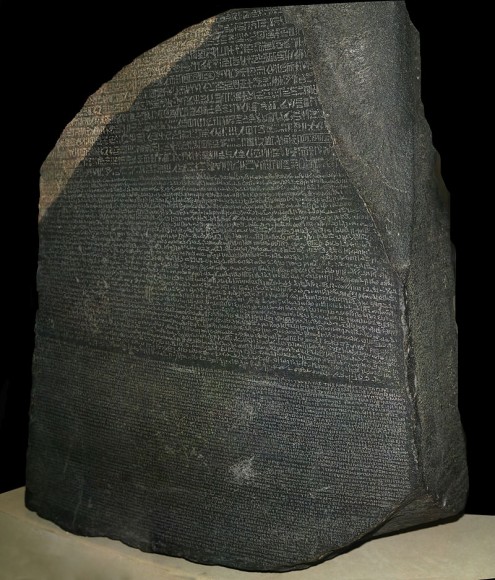| Online: | |
| Visits: | |
| Stories: |

| Story Views | |
| Now: | |
| Last Hour: | |
| Last 24 Hours: | |
| Total: | |
Communicating Across the Cosmos 4: The Quest for a Rosetta Stone

The Rosetta stone, now displayed at the British Museum in London, was used by Jean-Francois Champollion to decipher Egyptian heiroglyphics. The same message is given in three languages, Egyptian Hieroglyphics (top), Demotic (middle), and Greek (bottom). It is a useful example of what we may need to engage in interstellar communication, Credit: Hans Hillewaert, British Museum
On television and in the movies, it’s so easy. Aliens almost always speak English (at least in America they do). If it’s explained at all, we are typically told that they learned it by intercepting communications with our astronauts, or tapping into our television broadcasts. A universal translator device instantly abolishes communication difficulties. Hollywood aliens are, of course, human beings in costumes (these days augmented by computer graphics). They are equipped, as are we all, with a human brain, a human larynx, and human vocal cords; all singular products of the distinctive evolutionary history of our species.
Real extraterrestrials, if they exist, will be the product of a different evolutionary history, played out on another world. (…)
Read the rest of Communicating Across the Cosmos 4: The Quest for a Rosetta Stone (2,499 words)
© Paul Patton for Universe Today, 2014. |
Permalink |
No comment |
Post tags: Archeology, Astrobiology, Interstellar message, language, SETI
Feed enhanced by Better Feed from Ozh
Source: http://www.universetoday.com/116634/communicating-across-the-cosmos-4-the-quest-for-a-rosetta-stone/





Many extra-terrestrials try to communicate telepathically (albeit aided by technologies). Telepathy goes beyond “language” would be better described as “communicated understanding” (thoughts of no particular language). Communicated understanding is represented by words in the language of the receiver.
My blog now has an Anunaki (not spelling), Drakkon and Draco section.
Best
OT
http://ozziethinker.wordpress.com